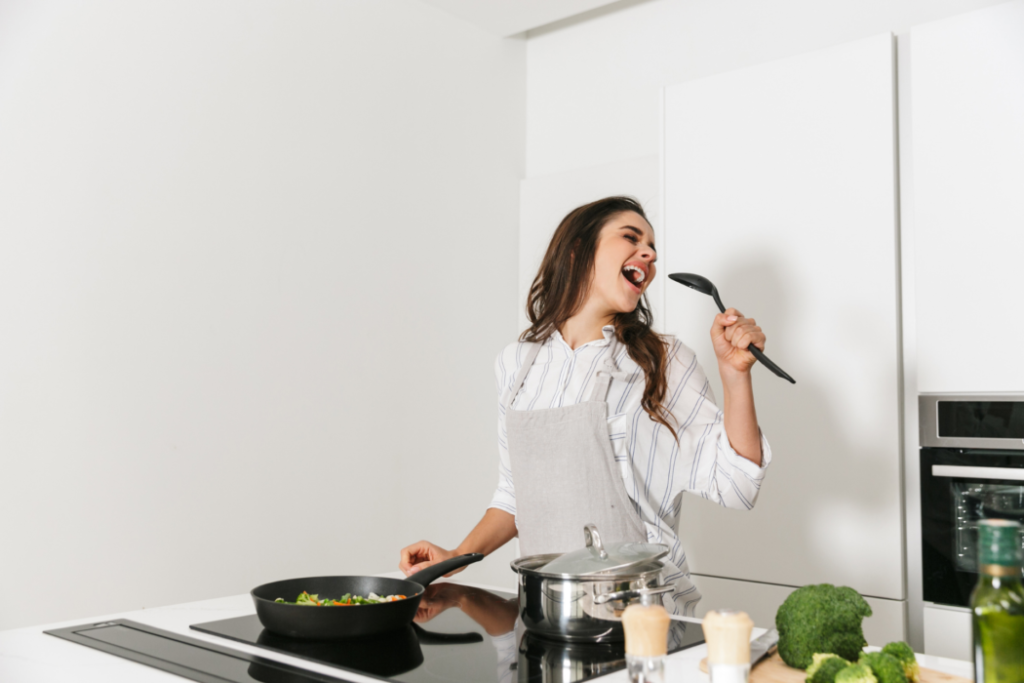Becoming a proficient home chef involves more than just having a passion for food. It requires a comprehensive understanding of various culinary techniques that can help you make the most of your ingredients and create delicious meals.
Here are some essential techniques every home chef should master.
Table of Contents
1. Knife Skills
Mastering knife skills is a crucial first step in your journey as a home chef.
From mincing garlic to dicing onions, the way you cut your ingredients can significantly impact the flavor and presentation of your food.
To get the most out of your kitchen time, practice these basic knife skills and you’ll be on your way to producing restaurant-quality dishes!
Improve Your Grip
Start with working on improving your grip. Your thumb and index finger should form a “V” around the back of the blade while your other three fingers support the handle. This will give you more control over the knife and make it easier to perform precise cuts.
Learn Cutting Motion
When cutting, use an up-and-down motion with each slice, rather than sawing back and forth. This will minimize tearing and create even, uniform pieces. For larger items, use a rocking motion to make your cuts quicker and more efficient.
Invest in Knives
Once you’ve mastered the basic techniques, consider investing in specialty knives for specific tasks.
For instance, a smaller knife is better suited for mincing vegetables while an offset serrated knife works best when cutting crusty breads.
Keep Your Knives Sharp
Finally, always keep your knives sharp. Not only will a dull knife be more dangerous to use, but it also won’t make clean cuts, which can lead to wasted food and money.
Regularly honing and sharpening your blades will ensure that they stay in top condition. With proper technique and maintenance, you’ll be slicing and dicing like a pro in no time.
2. Sautéing
Sautéing is a high-heat cooking method that can add a rich flavor to your dishes. This technique involves cooking food quickly in a small amount of oil or fat. It‘s a great way to add texture and flavor to vegetables, proteins, and starches.
Temperature
When looking to sauté food, the most important factor is temperature. The pan should be hot enough that the oil starts bubbling instantly when you add it in, but not so hot that it smokes. If your pan is smoking, turn down the heat or remove it from the heat completely for a few moments. Once your pan is at the right temperature, you can start adding food.
Various Cooking Time
It’s important to pay attention to the ingredients you’re sautéing. Different foods have different cook times and require different temperatures, so it’s best to add the food in stages.
Start with your vegetables if you’re making a stir-fry, then add proteins like chicken or tofu, and finally add starches such as grains or noodles.
When adding ingredients, make sure to evenly space them out in the pan so that they don’t overcrowd each other and can cook evenly.
Use a Right Kind of Oil
When it comes to oil, olive oil is often a great choice for sautéing because of its relatively high smoke point (the temperature at which an oil begins to burn). Be sure not to use too much oil, and if you need more as your food cooks, add it in small amounts.
With sautéing, it’s important to use the right kind of oil or fat for optimal results. The best fats and oils for sautéing are high in monounsaturated fats like avocado oil or extra-virgin olive oil.
Stir Your Food
Finally, once all of your ingredients are sautéing in the pan, be sure to stir or toss them occasionally to make sure that they cook evenly. This should be done for a few minutes until the desired texture and doneness has been reached. Once everything looks good, serve your sautéed dish and enjoy! If you’re looking to add a little bit of flavor to the dish, consider adding some herbs or spices such as garlic powder, cumin, oregano, and more. Bon Appetit!
3. Braising
Braising is a slow-cooking method that is ideal for tenderizing tough cuts of meat and hearty vegetables.
This technique combines dry and moist heat to break down the fibers in food, resulting in a melt-in-your-mouth texture.
It’s an ideal way to make the most of a bargain cut of meat, such as chuck steak, or to add depth and flavor to vegetables like mushrooms.
How To Braise Food
To braise, you’ll need a large pot that has a tight-fitting lid.
Begin by searing your food in hot oil over high heat until it is nicely browned. This will give it a flavorful crust.
Then add in any desired liquids, such as broth, wine or beer, along with aromatics like garlic and herbs.
Let the mixture come up to a simmer on the stovetop and then cover it tightly and move it to an oven preheated to 325°F (163°C).
Cook for 2-3 hours until your food is tender and succulent.
Finally, you can thicken the sauce by reducing it on the stovetop or whisking in a small amount of butter.
Enjoy! Happy Braising! 🙂
4. Roasting
Roasting is a technique that uses indirect, diffused heat (like an oven), and is suitable for cooking large or whole pieces of meat or vegetables.
This method helps to enhance the natural flavors and create a beautiful caramelized exterior.
Roasting is often used to prepare dishes for a variety of occasions, from weeknight dinners to holiday feasts.
It can also be used as a finishing technique after searing or grilling, which helps add extra flavor and texture.
Keep the Temperature Low
When roasting, it’s important to keep the temperature low enough so that meats don’t dry out while still allowing the exterior to develop a nice golden or caramelized crust.
This usually means an oven temperature around 350°F (177°C).
Make sure to check on your dish frequently, and turn the meat or vegetables occasionally so they cook evenly.
Use The Right Size Pan
It’s also important to choose the right size roasting pan. The pan should be large enough for the food and have at least 1 inch of space between the food and sides of the pan.
This will allow for proper air circulation, which helps to ensure even cooking.
Additionally, adding a small amount of oil or butter can help keep proteins moist and add flavor.
Roasting Vegetable Tip
When roasting vegetables it’s important to remember that they cook quickly, so they should be placed on the top rack of the oven.
Roasting vegetables at a higher temperature will help achieve that perfect charring and crispiness.
Roasting Meat Tip
Finally, when roasting meats, it’s important to remember to use a meat thermometer to check for doneness.
A rough guide is to remove proteins from the oven when their internal temperature reaches 145°F for beef, pork, or lamb and 165°F for chicken.
This will help to ensure that your food is cooked safely and that it’s delicious!
Bonus Tip
Before adding proteins to the pan, season them with a rub or marinade of your choice.
This will add flavor and complexity to any dish you make!
5. Poaching
Poaching is a gentle cooking method often used for delicate foods like eggs and fish.
By simmering ingredients in a flavorful liquid, you can keep your food moist and infuse it with additional flavors.
This method of cooking is also advantageous because it preserves the nutritional value of your food.
Poaching can be done in any liquid, from broth to wine and even water. So, whether you’re making fish for dinner or poaching eggs for breakfast, this cooking technique is sure to make a delicious meal!
Plus, you’ll enjoy all the health benefits that come with it.
Don’t forget to season your poaching liquid and add herbs for additional flavor!
With a few simple steps, anyone can master the art of poaching.
6. Baking
From bread to pastries, mastering the art of baking can open up a new world of culinary possibilities.
Baking is a cooking method that involves dry heat from an oven. This technique is most commonly associated with bread, cakes, pastries, and other desserts, but it can also be used for cooking a variety of other foods.
Key Skills for Baking Mastery
To bake effectively, preheating the oven to the appropriate temperature is critical. Uneven or insufficient heating can lead to poor rise or uneven cooking.
Next, prepare your ingredients, ensuring they are all at room temperature unless specified otherwise.
Mixing ingredients in the correct order and proportion is essential for achieving the right texture.
After your mixture is ready, pour it into a suitably sized baking dish or tin that’s been greased or lined to prevent sticking.
Place the dish in the center of the preheated oven to allow for even heat distribution.
Ensure to follow the recipe’s recommended baking time to avoid overbaking or undertaking.
Use a toothpick or a skewer to test for doneness; it should come out clean when inserted into the center of your baked good.
Finally, let your dish cool before cutting or serving.
Baking requires patience and precision, but with practice, it can yield immensely satisfying results.
7. Grilling
Grilling imparts a smoky flavor to food and creates a delicious charred exterior. Whether you’re cooking meat, seafood, or vegetables, grilling can provide a tasty and healthy cooking option.
Exploring Varieties of Grills
There are different types of grills, from charcoal to gas and electric. Depending on the type of grill you have, there are some tips to keep in mind when grilling.
Charcoal Grills
For charcoal grills, make sure to use the right amount of fuel; too much can lead to intense flames that could char your food before it’s cooked through.
It’s also important to monitor the temperature and adjust your vents accordingly so that you can control the heat.
Gas Grills
With gas grills, be sure to preheat them properly so they reach an ideal cooking temperature. After preheating, use a thermometer to check the temperature inside your grill.
Electric Grills
For electric grills, check the manual for instructions on how to use it correctly. Finally, always make sure to clean off your grill after each use and store your food appropriately before grilling.
Follow these tips and you’ll be grilling like a pro in no time!
Have fun with your grilling and don’t forget to experiment – try different marinades or rubs, switch up the type of wood chips you use for smoking, or even try a new recipe.
Endless possibilities await with grilling – You can even use your grill for baking pizza, roasting vegetables, or making s’mores.
With the right tools and safety rules in mind, grilling can be one of the most enjoyable parts of the summer season. So go ahead and fire up that grill – you’ll be sure to have a delicious meal in no time!
Grilling is a great way to give your meals that extra special touch, so don’t forget to enjoy yourself while you cook!
Conclusion
By incorporating these techniques into your cooking routine, you’ll soon impress your friends and family with your culinary creations. Remember, practice makes perfect, so don’t hesitate to experiment and refine these methods.
In summary, mastering these cooking techniques can elevate your culinary skills, transforming even the simplest ingredients into gourmet masterpieces.
From the rapid sear of stir-frying to the slow simmer of braising, each method uniquely enhances the texture and flavor of your food. By understanding and applying these techniques, you can turn every meal into a creative endeavor and embark on a fulfilling culinary journey.
Enjoy the process, explore different flavors and techniques, and most importantly, savor the delicious results of your hard work. Happy cooking!



